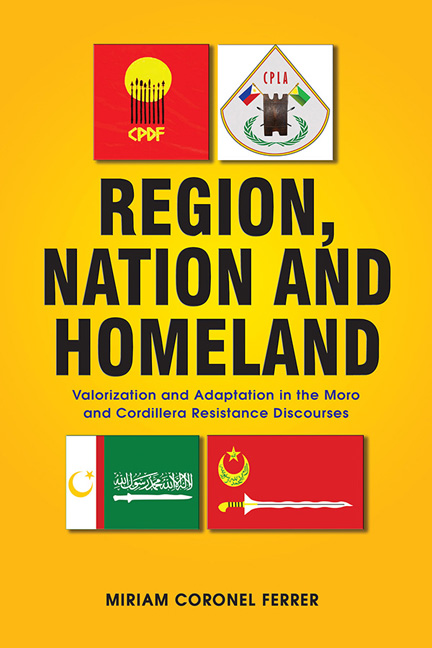 Region, Nation and Homeland
Region, Nation and Homeland Book contents
- Frontmatter
- Contents
- Preface
- List of Abbreviations
- Maps
- 1 Introduction: Text and Resistance
- 2 The Moro Liberation Movement: From Secession to Autonomy
- 3 The Cordillera Movement (1970s–2008): Building and Losing the Consensus
- 4 Nation, Homeland and Ancestral Domain: Intertextuality in the Moro Discourse
- 5 Identity Ambivalence in the Pan-Cordillera Discourse
- 6 Conclusion
- Bibliography
- Index
- About the Author
2 - The Moro Liberation Movement: From Secession to Autonomy
Published online by Cambridge University Press: 02 April 2020
- Frontmatter
- Contents
- Preface
- List of Abbreviations
- Maps
- 1 Introduction: Text and Resistance
- 2 The Moro Liberation Movement: From Secession to Autonomy
- 3 The Cordillera Movement (1970s–2008): Building and Losing the Consensus
- 4 Nation, Homeland and Ancestral Domain: Intertextuality in the Moro Discourse
- 5 Identity Ambivalence in the Pan-Cordillera Discourse
- 6 Conclusion
- Bibliography
- Index
- About the Author
Summary
“Whereas, the MNLF, led by Professor Nur Misuari, inspired by the quest for peace and prosperity, had in the past asserted the right of the Moro people to freely determine their political status and pursue their religious, social, economic and cultural development…”
— The Final Agreement on the Implementation of the 1976 Tripoli Agreement between the Government of the Republic of the Philippines and the Moro National Liberation Front (para. 2), 2 September 1996“Underlying the CAB is the recognition of the justness and legitimacy of the cause of the Bangsamoro people and their aspiration to chart their political future through a democratic process that will secure their identity and posterity and allow for meaningful governance.”
— The Comprehensive Agreement on the Bangsamoro (para. 3), signed by the Government of the Philippines and the Moro Islamic Liberation Front, 27 March 2014The events and circumstances that gave rise to the armed conflict in Mindanao are multiple and complex. Some scholars, the popular media and protagonists alike have described the conflict as a “religious war”. This perception may have been fed by the way the Spaniards framed and justified their colonization campaign in the past that resulted in deeply ingrained prejudices held between the Christianized natives and the indigenous followers of Islam. The perception was bolstered with the rise of communal conflicts in parts of Mindanao in the early 1970s involving vigilante groups among the settler and indigenous communities, often arising from land-related disputes or contestation over political and/or territorial control.
Seeds of Discontent
The hostility draws on historical antecedents that saw the Islamic population in the south marginalized from the centre of politics and society located in the northern capital on Luzon island. Moreover, policies undertaken by the American colonial regime and the Philippine Republic significantly changed the demographic composition and social structure of Mindanao. Notably, the series of resettlement programmes of populations from Luzon and the Visayas to Mindanao initiated by the American colonial regime transformed many segments of the indigenous population into minorities. The succeeding Philippine government pursued the same policies. Mindanao thus developed into a settler colony from the early to the mid-1900s. Homestead arrangements for migrants and the infusion of American capital for the plantation economy in the region hastened the loss of control over land and tribute collection in the hands of the original inhabitants.
- Type
- Chapter
- Information
- Region, Nation and HomelandValorization and Adaptation in the Moro and Cordillera Resistance Discourses, pp. 13 - 56Publisher: ISEAS–Yusof Ishak InstitutePrint publication year: 2020


